Holland America Line
Holland America Line is one of the few companies that survives from the time of the oceanliner-era. But it is not the same company it was before. When you see their website you will find a little flag of the NASM in the corner and that's all you can find about shipping. The company now is an investment company investing in companies with international allure. Although shippingcompanies are, they are not working with HAL.
In the miniature city Madurodam at The Hague (shouldn't Madurodam be a Holland America name too?) a replica of the former offices is presented, just close to the massive model of the fifth Rotterdam, built in 1958. A picture of the Rotterdam model can be seen at her page.
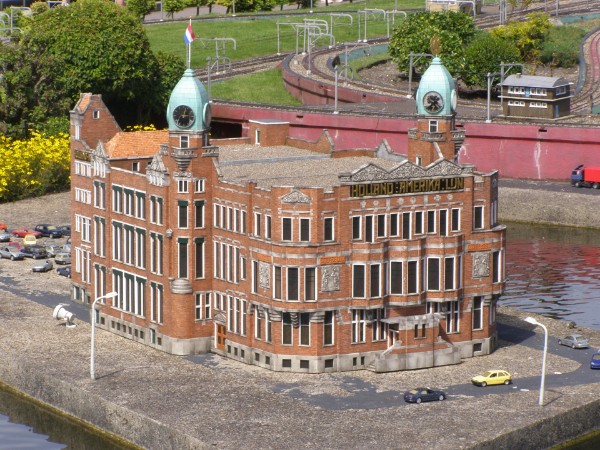
...and of course the real deal...
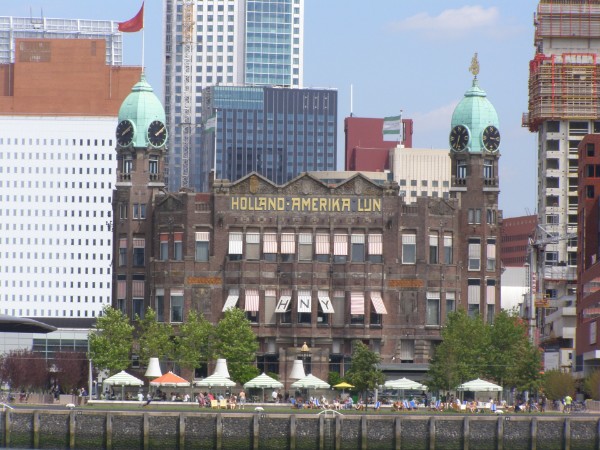
Holland America Line was founded in 1870, as a thirth attempt to start a steamline between The Netherlands and north America. The first two attemps failed, mainly because the conservative Dutch wouldn't start off into steam, because the country's wharfes had a great know-how of building sailingships. The first ship that entered service for the company, that was founded under the name of Commanditaire Vennootschap Plate, Reuchlin & Co., was named Rotterdam, in honour of the city where she would sail from. But because the ship was not ready on time, they had to charter a ship from Rotterdam Lloyd called Ariadne to make the first trip between Rotterdam and New York in 1872. One year later, to raise capital for new ships, the company was renamed as the NV Nederlandsch-Amerikaansche Stoomvaart-Maatschappij, or NASM. Normally, 1873 is seen as the year where-in the Holland America Line was founded, but as you can see, that is not exactly right.
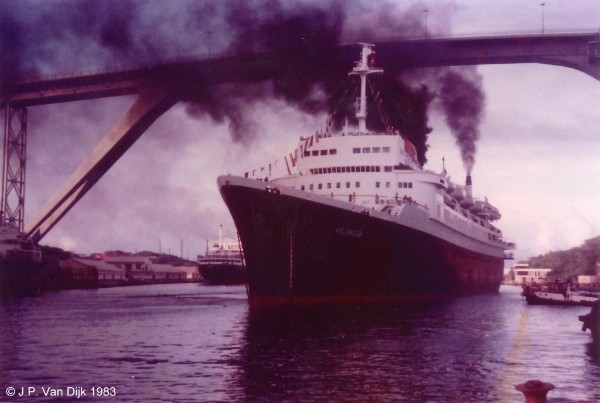
Above, a heavily steaming Volendam enters the port of Willemstad, Curacao in the summer of 1983. This picture was sent to me to use on the site with kind permission from mister J.P. van Dijk from Rotterdam. You can also spot the stern section of the 1958-built Rotterdam to the left. The Volendam had been built for Moore-MacCormack in 1958 and was bought as a cruiseliner for Holland America Line in 1972.
There was a slight problem, because Rotterdam wasn't connected to the sea in an easy manner. The river Maas was going in that direction, but was very shallow so the first ships had to sail all the way round through the Zeeland region loosing much precious time. An old plan of Nicolaas Samuelis Cruquius of 1739 was finally used in 1858 by a man named Pieter Caland, who proposed a new waterway from Rotterdam to the sea, breaking the dunes at a place called Hoek van Holland. Finally, in 1863 digging began thanks to a new law, that also made it possible for Amsterdam to built the Northsea Canal, because they suffered the same problems. The new waterway was finished in 1875, just in time for the larger ships of the NASM to use. For conveniece, the new waterway to the sea was called the New Waterway and it still is.
In 1880, the NASM was offered dockingspace in the port of Rotterdam at the Stieltjesstraat at Fijenoord, very close to the current cruiseterminal, but in 1891 the company was awarded a newly built dock and that was called the Prinsessenkade, or in English the Princess Quay. Later, this was renamed as Wilhelminakade, the place where the ships have sailed from ever since, and the current location of the cruiseterminal. In New York, the company used a pier at Hoboken from 1889 onwards.
At the Wilhelminakade, the two funnels of the Nieuw Amsterdam from 1938 are used as a reference to this combined statue. It is a great way to remember the history of the company this way, but sad that these funnels haven't been painted in the original colours.
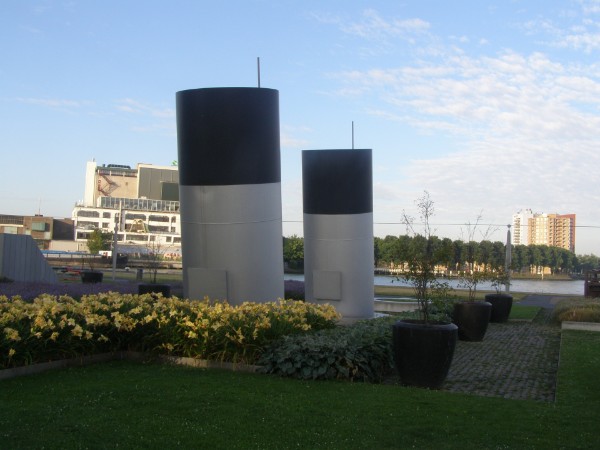
As whole the pier and surroundings is rebuilt and re-develloped, with a great eye for the hitstory of the Holland America Line, the twin funnels of the Nieuw Amsterdam that are pictured above, now also have a modern counterpart, the twin funnels of the Vista class are placed just next to the Hotel New York. Notice that they are slightly different then the original funnels.
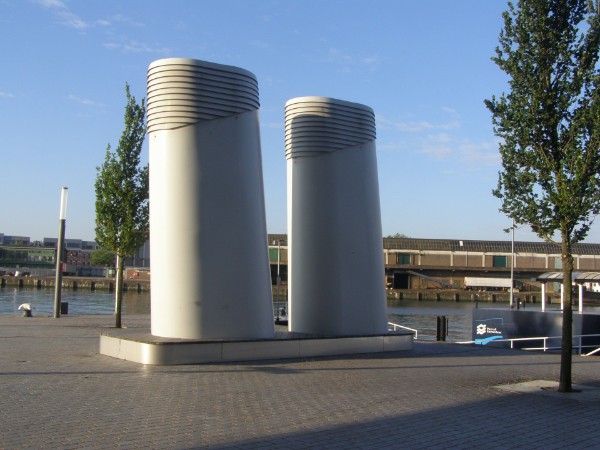
In 1896, the company renamed itself as NV Nederlandsch-Amerikaanse Stoomvaart-Maatschappij 'Holland Amerika Lijn', adding the common name that was already used to its original title. After this, the company itself started to push back the NASM part of the name, the trading name Holland Amerika Lijn became the most important one.
The NASM grew not only in name, but also in the number of ships, and at the Wilhelminakade, new warehouses, a hotel, a church and a coffeehouse were built. From 1901 onwards, the headoffice was built also here, it was finally finished in 1922 and today it is in use as the Hotel New York, one of the landmark buildings of the port of Rotterdam and one of the few memories of the liner-era in the world that is is so good shape and original state. In 1902, Holland America Line sold 51% of its stock to the Harland & Wolff wharf at Belfast, Northern Ireland to try and find connection with other lines. Harland & Wolff was an important part of the International Merchantile Marine Corporation of the banker J.P. Morgan, a combine of important Atlantic Lines. Harland & Wolff sold half of the stock to the German companies HAPAG and Norddeutscher Lloyd, so technically, Holland America Line was now partially a German firm. This caused some problems during the first worldwar, because Great Britain did not want to do business with the German Holland America Line! Between 1915 and 1917, Holland America Line bought back the stocks and disconnected from the IMMC.
In those years, Holland America Line invested in great new ships like the 1908-built Rotterdam of 24.000 tons, the 1917-built Statendam (that was sadly lost as the British Justicia before entering Holland America Line service, measuring the staggering 32.234 tons. She was in fact built as a smaller version of the White Star Olympic-class of ships) and the 1929-built Statendam, that was to be the latters replacement at a tonnage of 29.511. Just before the second worldwar broke out, the company built one of the most splendid ships ever to sail the North Atlantic, the 1938-built Nieuw Amsterdam. She still is widely recognized throughtout the world as such.
The former Holland America Line offices seen from the bridgewings of the 1959-built Rotterdam, that is now docked so close to the historic HAL-quaysides. As you can see in the picture, the green towers, once true landmarks and the highest points at this side of the river, have now long been overtaken by modern times.
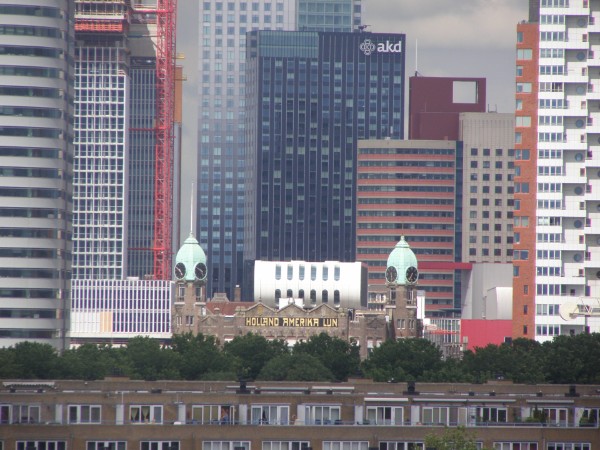
After the second worldwar, it took a while to introduce another great ship of state, a runningmate for the great Nieuw Amsterdam. Several ships were built in the 1950's, but in 1958, the last of the great Dutch liners was built at the Rotterdam Drydock Company as a true testament of the resurrection of the whole country after the devastating war. Especially Rotterdam, that was bombed in 1940 and destroyed almost completely. Only one name could be fitting for her, so she was named after the city where she was born as the fifth Rotterdam. She sailed for the Holland America Line untill she was finally sold in 1997, having been in service for the company for 38 years.
In New York, the company also made big steps. From 1963 onwards, they opened their new pier at the Manhattan side of the Hudson river and this was the largest pier that was ever constructed for a shippingline. Of course this was pier 40, used by Holland America untill they withdrew from transatlantic voyages. Today, the pier still exsists, a picture can be seen at the page about the New York liner memories oin this site.
But in the beginning of the 1970's, the core business of the company declined sharply and in 1971, the company withdrew from transatlantic voyages completely. In 1975, the companies large fleet of freightships, where all names ended at 'Dyk' was sold and they concentrated solely on the cruisebusiness. Luckily, Rotterdam was easily adapted to this new business and several ships were added to the fleet in the 1980's.
The shipping and tourism part of the company was bought by Carnival Corporation in 1989 and is now trading under the Holland America name while the original company is HAL Investments. In the 1980's, HAL was, like P&O and HAPAG-Lloyd also for example, a very diverse company where shipping is just a part of a much bigger venture. When Carnival made a good offer for the name and the ships, the company understood that with that sale the passengerdivision could grow in a direction where it could never go under their original owners.
As a reminder of all who travelled from these quays, the statue 'The Lost Luggage Depot' was created by Jeff Wall and opened in 2001.
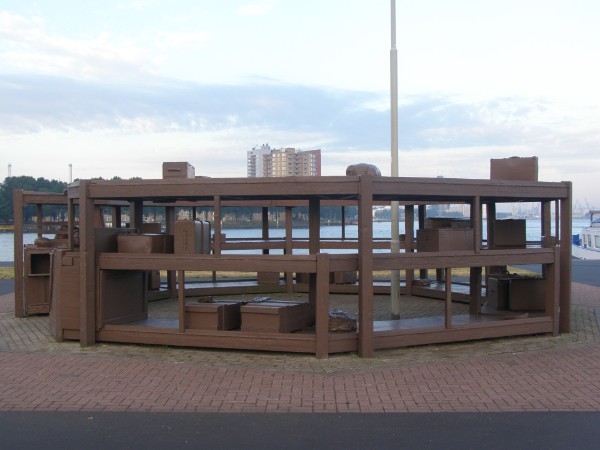
It was sad when the tourism-part was sold, because the old company had always been built around the shipping-operations. But when we see what Holland America Line is now, with the ships again under Dutch flag, a new European headoffice just next to the old one in Rotterdam, more and more attention for the history of the Holland America name and ships and of course their still elegant ships remembering a time when Dutch shipping was booming, we can be proud that Carnival brought the company where it is now. The Americans did save so many old shipping names and of course, it would me much more beautiful when all these companies were still independent. But they do still exist now, and these names give us a true link to the past.
Under Carnival ownership, the old line was built up to one of the most influential lines in the cruise industry, the fleet growing to 15 large passengerships in 2014. In april 2016, the company recieved its largest one to date, closing in at 100.000 tons the new Koningsdam will be the first Pinnacle-class liner. It will be the first time the name will be used for the company, honouring the first king of The Netherlands in over a century, King Willem Alexander. Nice sidestep is also to mention that the Koningsdam is also a quay in the oldest harbourdistrict of Rotterdam, very close to the cruiseterminal at the other side of the Maas river. Another ship of this class will be introduced in 2019 under the rather suspicious name Nieuw Statendam. This name has to represent the past with the Statendam-part, but also the future so she will recieve the 'Nieuw'-prefix, meaning 'new' in Dutch. Of course there is also Nieuw Amsterdam, but she was named after the former name of New York. For us Dutch, the name Nieuw Statendam is a little odd and still meaningless, but maybe that will change when she is here...
I have to say I am very proud of the history of the Holland America Line, of course as a Dutchman. But also, I think Holland America lives on in a very good way in our modern time. Rotterdam is really a place where you can sense the history of the line, sleep in Hotel New York, the former headoffices or visit one of the former flagships. The building is beautifully restored and still has a lot of ornaments from the time it was the HAL office. The quaysides that were used in the best days of the line are nowadays still in use as the city's cruiseterminal, docking ships to the likes of Queen Mary 2, Grand Princess and Norwegian Epic, that are among the largest cruiseships of our time. The former departurehall for the transatlantic crossings is now in use as the cruiseterminal, not demolished like the terminals at Southampton and Le Havre. All streets on the pier in Rotterdam are named after famous ships the line once sailed with, and still sails with. Although it is another company now, its history can be sensed through the ships of today. Next to the old offices, in the new Montevideo building, the HAL has opened its European office, returning officially to the city at the Maas river, where it all started. Besides all, Rotterdam is the only port in the world that has one of the ships that really sailed from here opened to the public. A ship that is so closely connected to its surroundings, so different from a ship like the first Queen Mary, that is preserved in a town that has nothing to do with her history whatsoever. For liner history, Rotterdam is just unique. Another great link to the past was created there when the sixth Rotterdam was truly homeported year-round in her namesake port. Again, no other port in the world still has an equally named ship sailing yearround from its quays, also sailing under that countries own flag. Within the next pages, the ships of the Holland America Line that I have seen and photographed are feautured. De historie gaat verder (The history goes on).
The funnels of the Noordam reflect into the windows of one of the restored warehouses at the Holland America Quay, as the street is now called. To me, this pictures just tells the tale. Holland America ships still berth at the old departurehall. Liner history is sometimes closer then you'd think.
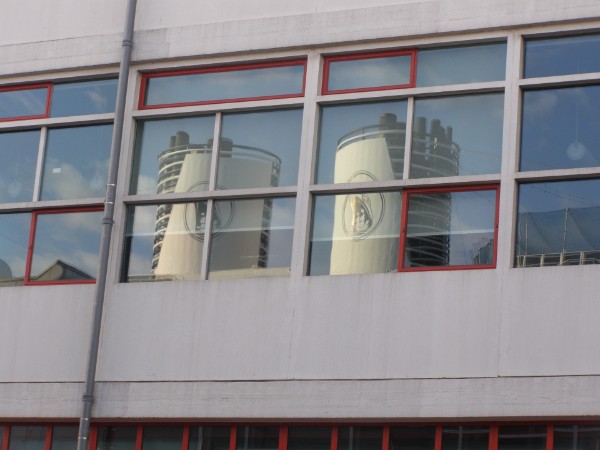
Ships that have sailed for Holland America Line but are placed elsewhere at this website are
Nieuw Amsterdam (1982-2003) is placed under Marella Cruises as Thomson Spirit
Noordam (1983-2004) is placed under Marella Cruises as Thomson Celebration
Westerdam (1986-2002) is placed under Costa Cruises as Costa Europa
Statendam (1993-2015) is placed under CMV Cruises as Vasco da Gama
Amsterdam (2000-2020) is placed under Fred. Olsen as Bolette
For booking information, visit the website of Holland America Line.

